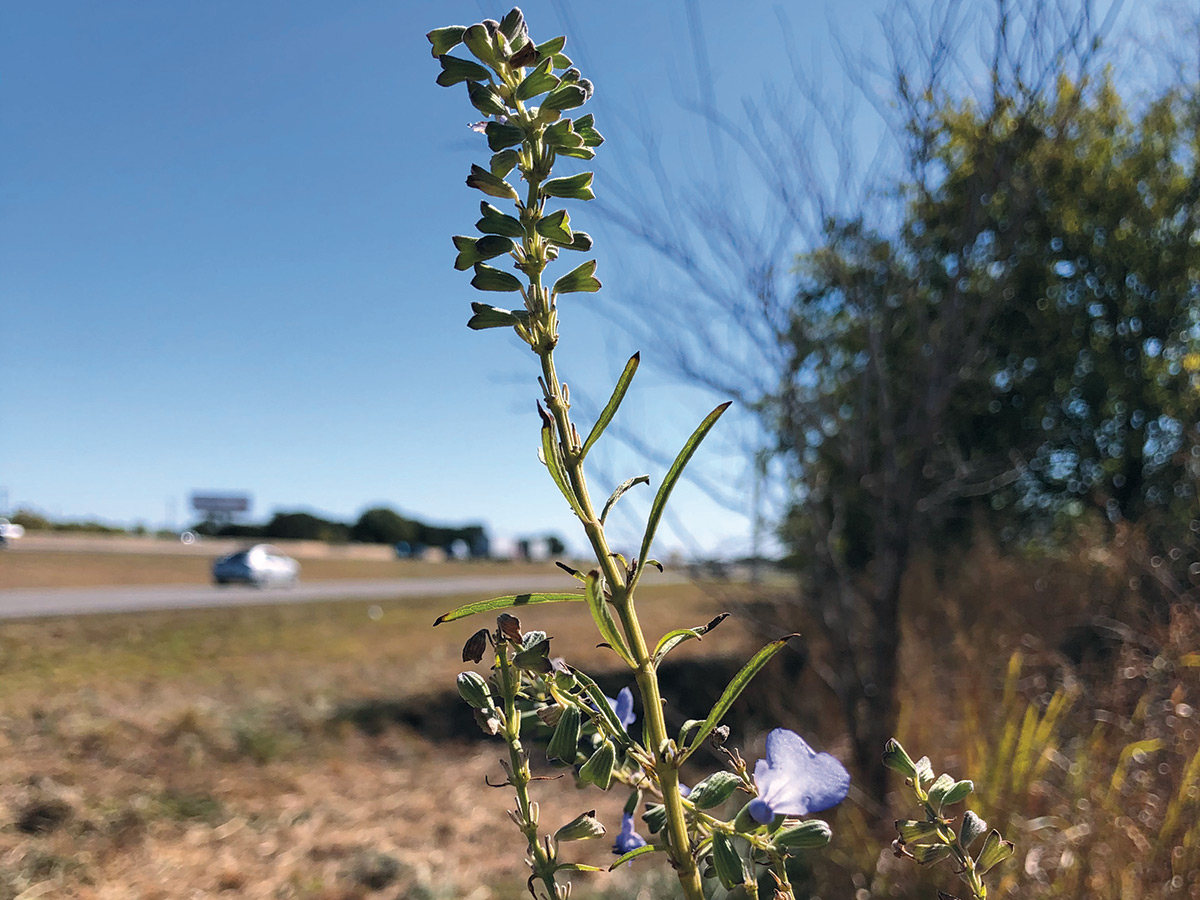Pet Prairies

This pitcher sage, a native wildflower, had just missed being mowed when Marr spotted it last October on the edge of I-35. PHOTO Minnette Marr
Most of us have go-to, time-killing activities when we’re stuck in traffic: We check our phones, answer a few messages, bite our nails, check our hair, zone out. Minnette Marr does something else entirely. She looks for plants — particularly those that could signal the existence of an unknown remnant of native Texas prairie.
Marr is the Wildflower Center’s conservation program manager, and she saw just such a plant along Interstate 35 southbound, on her way home to San Marcos. Sitting in traffic, her eyes wandered west, and she noticed spikes of green-white flowers on what she thought might be Arkansas yucca (Yucca arkansana). This required further investigation.
What she found was “a little remnant prairie sandwiched between the southbound service road and a railroad track and private property with a barbed wire fence.” The roughly 200-by-40-foot plot contained Arkansas yucca and a host of other interesting native prairie species, including an uncommon goldenfruit sedge (Carex aureolensis) and a native hemp known as prairie dogbane (Apocynum cannabinum). She discovered the latter when roaming the site with a headlamp after dark. This is not something Marr does in an official work capacity; it’s a labor of love, a task she engages in on her own time because she’s just that curious about native plants — and that concerned for their welfare.
Marr believes this particular area is preserved because “it is immediately associated with a support stand for a large electrical wire.” When crews come in to mow — which they do because, as she puts it, “It is easier to mow a cedar elm sapling than to cut down a cedar elm tree” — they are forced to leave a buffer around the support. Similarly, prairie advocate Matt White, author of “Prairie Time: A Blackland Portrait,” says remnants are often found in areas that are hard to plow or mow, such as bluffs, cliffs, rocky outcroppings and creek bottoms.
He also claims that prairie-spotting is not a task best left to experts; Lan Shen, a volunteer with the Houston Chapter of the Native Prairies Association of Texas, agrees. Shen believes saving genetic material by collecting seeds and rescuing plants is not only worthwhile but contagious. “When someone who is passionate about the prairie interacts with other people, others often catch the enthusiasm,” she says.
Marr notes that any long-lived plants with deep roots, such as little bluestem (Schizachyrium scoparium), are a good sign. Another interesting species she encountered and harvested seeds from is prairie acacia (Acaciella angustissima). Those seeds will go into the Wildflower Center’s Hill Country Trails area. It’s this type of practical conservation that she considers essential now, particularly due to the disappearance of native landscapes she’s witnessed firsthand.
“So many of the sites that I was familiar with [from previous collecting] have just disappeared,” says Marr. At the time, she and collectors were careful to only take 20 percent of the seeds or fruit produced in order to leave a healthy wild population intact — “and now the entire population or entire site is gone,” she laments. A lot of those areas now have shopping centers on them, were damaged by flooding, were flattened for recreational use, have experienced land-use change, or have fallen victim to robust invasive species such as giant cane (Arundo donax) shading out plants that need more sun.
That’s why it’s so important to spot native prairie remnants. Even a small suite of plants like Marr’s commute-home plot can be rich with species that are hyper-locally adapted. “They’ve lived with local rainfall and changes from year to year for centuries if not millennia,” says Marr, “so they’re as well adapted as they can be.”
Her goal in working with groups such as the Hays County Master Naturalists and the Austin NPSOT Chapter is to make small collections from these remnants and get the seeds out to new sites. “If you get the seeds back out in their habitat, the plants will become re-established and usually spread on their own,” she says. Her advice is to start small and “focus on that one plant that grabbed your attention to begin with.”
Though she was disappointed that she couldn’t collect seeds from the Arkansas yucca or the hemp (the flowers were browsed by deer), she eventually found the prairie acacia, the sedge and “all these things I would never have seen sitting in traffic,” she says. “It’s a learning process.”
And you know Marr will be back, keeping an eye on this small, preserved-for-now prairie. She recommends spending 15 to 20 minutes at your pet prairie even twice a month, just observing. Better than sitting in traffic.

